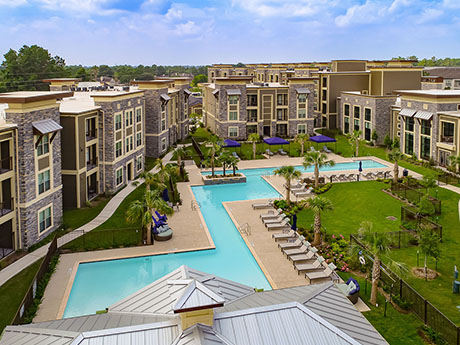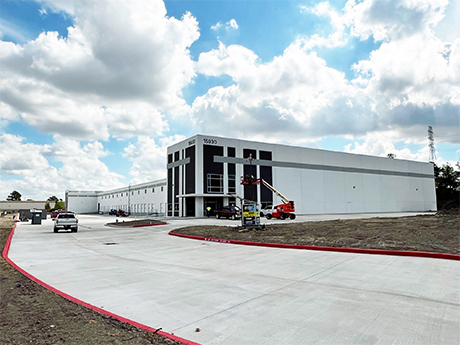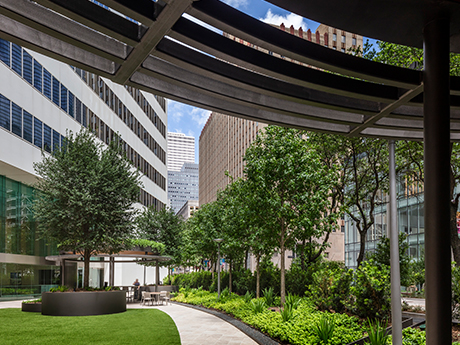Historically, the fortunes of many commercial real estate endeavors in Houston have been tied to the energy sector.
But as developers and leasing agents across all major property types know, the market now boasts a much more diverse set of growth drivers, including regional distribution, healthcare, aerospace/defense and financial services. Each of these industries fuels growth in development and absorption of commercial space, not to mention housing.
Yet even to the layman, these industries are as different as the commercial structures that house their operations. And taken collectively, the performances of Houston’s commercial properties do not always paint a wholistic picture of the larger economy. That holds especially true in times of larger macroeconomic disruption like the present.
Texas Real Estate Business recently reached out to developers/owners, as well as leasing agents/managers who are deeply immersed in the Houston multifamily, industrial, retail, office and mixed-use sectors. By posing a quintet of questions that are — almost — equally applicable to each of these asset classes, we uncover insights on how the five major food groups are performing on a relative basis.
Participating in the Q&A are Matt Bronstein, vice president at BHW Capital (multifamily); Robert Clay, president and co-founder of Clay Development (industrial); Jason Baker, co-founder of Baker Katz (retail); Dougal Cameron, president of Cameron Management (office); and Jason Johnson, CEO and president of MetroNational (mixed-use).
Their edited responses are as follows:
Texas Real Estate Business: How have interest rate hikes and disruption in the capital markets over the last two years impacted your business, and what expectations do you have along those lines for 2024?
Matt Bronstein: The rising cost of capital, instability in material costs and flattening of rent growth have made starting new multifamily developments more challenging. The result is that the risk-adjusted return premium has not warranted the additional risk.

We anticipate “higher for longer” interest rates. However, when coupled with market stability, we will be able to pursue new development opportunities in 2024 because we can more conservatively underwrite the risk variables.
Robert Clay: Houston saw an explosion of industrial construction starts during the pandemic through the end of 2022. With interest rate increases in late 2022 and throughout 2023, construction starts fell dramatically.
While one can argue that the market was “overbuilt,” it’s also true that leasing demand has remained strong, with vacancy holding below 8 percent despite a massive amount of product being delivered. We feel that the vacancy rate will continue to tick lower with fewer starts and continued demand.
Jason Baker: Inflationary pressures on materials, labor and everything associated with new development have made it virtually impossible to build new retail projects. As a result, we’ve seen a shift to investors focused on buying stabilized assets.
In recent years, there has been a big delta between what sellers/owners think their property is worth versus what buyers are actually willing to pay for it. In the past 12 months, there has been little activity on the acquisition and development side. However, we believe the bid-ask gap between owners and buyers is already starting to shrink and that 2024 stands a chance of being a good year for acquisitions for developers/owners with plenty of dry powder.
Dougal Cameron: Interest rate movement has had minimal impact on the office sector. COVID-19 and working from home remain the forces that have fundamentally changed the office building business, and movement in interest rates and capital flows cannot fix it.
Jason Johnson: There are always economic factors that can impact business, but MetroNationa’s expectations remain as they always have — to stay true to our roots as community and experience builders while innovating to deliver what people want and need. We stay close to our customers and employees and are thoughtful in our decision-making processes.
TREB: What are the biggest demographic and/or economic attributes that Houston has that are advantageous to your business?
Bronstein: Population growth, job growth and a pro-business regulatory environment have all been tremendous economic tailwinds for Houston multifamily. The growing population push to the suburbs has contributed to the steady increase in suburban multifamily leasing demand.
Clay: Houston has multiple drivers to support continued demand for industrial space. These include Port Houston, population growth, a low cost of living, a supply of both young and experienced laborers, the title of “energy capital of the world” and internationally renowned medical, space and research institutions and businesses.

Baker: Texas continues to be highly regarded market on a national scale. We are seeing corporate relocations due to the reasonable cost of living and friendly climate, which is resulting in tremendous population growth. As the saying goes, retail follows rooftops, so we are very happy to be in Houston as Texas continues to be a top place to live and do business.
Cameron: Job creation remains the most important point of emphasis and driver of growth and absorption, so we are prioritizing becoming a “vertical entrepreneurial village” — a place where entrepreneurs live, work and play. Right now, we have all of those components except “live.”
Johnson: Houston is diverse and welcoming, with many companies that attract and recruit top talent from all over the world. We benefit from being surrounded by the key energy, manufacturing, tech, medical and hospitality sectors that make our city great.
Job growth is our biggest advantage as our city is experiencing positive growth over the past year in arts and entertainment, retail and wholesale trade, manufacturing, healthcare, professional services and insurance, all of which affect our tenant mix and volume of visitors to Memorial City. Our office occupancy rate continues to exceed 94 percent on average.
TREB: How would you characterize the supply-demand balance in Houston for the physical real estate that is relevant to your business, and how big of a factor is that dynamic in your business strategy?
Bronstein: Going into 2024, the overall supply-demand balance for Houston multifamily is generally balanced. Houston’s new supply pipeline is at a relatively normal historic level, especially when compared to the other major Texas markets. The population growth and increased cost of homeownership continue to fuel the demand side. This balance is a key, as it represents one of our primary underwriting factors for rent growth.

Clay: We have timed our projects to meet the continuing strong tenant demand in the market. We build to meet the demand in selected submarkets and with building designs for today’s industrial users.
Baker: Baker Katz executes developments and investments on the principal side, as well as provides tenant representation for retailers across the country. It’s hard to remember a time in the past 25 years when occupancy and rents in Houston were so high. Despite little retail space being added to the market today, the sector continues to perform extremely well, albeit with significantly more competition for space.

On the tenant representation side, our business strategy remains: represent quality retail brands we believe in, provide great local knowledge to clients and maintain relationships with local and national landlords. On the development side, if we buy something, we tend to keep it. That is especially true today. Occupancy is high, and we don’t anticipate that changing anytime soon.
Cameron: It’s hard to overstate how big the gap between supply and demand in the office sector is — truly a tale of two cities. The best Class A buildings are fine and have good long-term values. Empty or near-empty buildings like 919 Milam and the old Exxon Building are worth less than $0. Every other building that is in between, like Esperson and Pennzoil Place, is likely to incur huge lender writedowns.
Johnson: Overall, the city is fairly balanced in this respect. What affects us the most for our strategy at MetroNational in attracting business is creating a sense of community for our residents, tenants and visitors. That means creating high-quality environments and providing well-maintained and secure spaces for those people.
TREB: Would you characterize Houston in 2024 as a buyer’s market or seller’s market as pertains to your business? What about a landlord’s versus tenant’s market?
Bronstein: We anticipate being net buyers in 2024 for Class A multifamily deals in Houston. As a result of the market resetting, BHW Capital has raised significant equity to opportunistically acquire quality assets that may require recapitalizations or repositioning.
Houston continues to be a market where the cost to rent is less than the cost to own, which contributes to Houston being a landlord’s market. However, affordability continues to be a concern as rental rates shot up very quickly and have recently plateaued. With a constrained supply pipeline, we are optimistic that rent growth will return to normalized and sustainable levels in 2024 and beyond.
Clay: Houston in 2024 is both a buyer’s and seller’s market; it depends on what you are looking for and in what area of town. To reiterate, demand is still high, but construction starts have slowed dramatically. The second part also depends on the market — for distribution, it’s pretty even for the reasons stated above. For manufacturing, it’s a landlord’s market because no one is building new manufacturing space right now.

Baker: From investment standpoint, Houston is a buyer’s market given the state’s strong growth metrics. If you’re a retailer expanding in Texas, it is a landlord’s market. Landlords are charging more to deliver less. In almost any retail vacancy today, there is a line of tenants willing and waiting to take the space.
Cameron: Houston is most definitely a buyer’s market for office investors, but it remains unclear as to whether the market has bottomed out. Just look at buildings like 1010 Lamar and 1001 Fannin. Tenants that can pay rent can pick and name their deal.

Johnson: For our development in Memorial City, it is a landlord’s market, but we use that as an advantage to transfer that back to our tenants and residents in creating more than just living and working spaces — we aim to foster communities where you can thrive in every aspect of life.
TREB: Looking to the new year, what would you say is the single-biggest point of optimism for your business in Houston, and what is the single-biggest point of concern?
Bronstein: Positive net migration to Houston continues to be one of the strongest economic tailwinds for the Houston multifamily market. As for concerns, we see rapidly rising operating expenses with limited control, specifically property taxes and insurance. This is a critical pain point in the multifamily industry today that cannot be easily solved or mitigated.
Clay: The size and variety of Houston’s industrial tenants — from manufacturing to third-party logistics to energy to high-tech — are the best indicators of the potential for industrial development. Our single-greatest concern is locating and pursuing projects tailored for the needs of today’s industrial tenants.
Baker: We are cautiously optimistic about 2024. Looking at last year as an example, the Federal Reserve raised interest rates, an election year was on the horizon and two international wars were going on. But despite all that, 2023 turned out to be extremely fruitful for many in the retail industry. The beginning of this year feels similar to last year, so 2024 could be great year for both brokerage and investment activity.
One major concern that remains top of mind during an election year, in Texas specifically, is the country’s immigration and border control policy. This issue, no matter what side you sit on, has the potential to make a significant impact on the Texas economy, depending on how the resolution unfolds.
Cameron: On the positive side, there should be buying opportunities for distressed buildings like Esperson, Pennzoil Place and 919 Milam for very low amounts, with opportunities to incubate new tenants in them. The biggest concern is that entrepreneurs will be crushed by large business ventures for anti-competitive reasons.

Johnson: Our single-biggest point of optimism lies in our ability to consistently please the community with more top choices for dining and shopping and welcoming visitors with a buzzworthy retail and restaurant scene. We have many first-to-market, first-of-its kind or first-to-Texas brands. These include retailers like Mango and restaurants like Credence and Sidebar from Levi Goode, Haywire and The Pit Room. All of these will be impacting our local economy with thousands of new employee hires this year.
The single-biggest point of concern is continuing to maximize and leverage our resources effectively to ensure that every child has what they need to grow and flourish in our city towards a bright future.
— This article originally appeared in the March 2024 issue of Texas Real Estate Business magazine.


